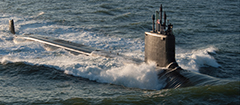Virginia Class Submarine
The Virginia class, also known as the SSN-774 class, is a class of nuclear-powered fast attack submarines (SSN) in service with the United States Navy. The submarines are designed for a broad spectrum of open-ocean and littoral (shallow coastal water) missions. They were conceived as a less expensive alternative to the Seawolf-class attack submarines, designed during the Cold War era. They are replacing older Los Angeles-class submarines, many of which have already been decommissioned. Virginia-class submarines will be acquired through 2043, and are expected to remain in service past 2060. Based on recent updates to the designs, some of the Virginia-class submarines are expected to still be in service in 2070.
The class was developed under the codename Centurion, renamed to New Attack Submarine (NAS) later on. The "Centurion Study" was initiated in February 1991. Virginia-class submarines were the first US Navy warships designed with the help of computer-aided design (CAD) and visualization technology. By 2007 approximately 35 million labor hours were spent on designing the Virginia class. Around 9 million labor hours are required for the construction and completion of a single Virginia-class submarine. Over 4,000 suppliers are involved in the construction of the Virginia class. Each submarine is projected to make 14–15 deployments during its 33-year service life.
 The Virginia class was intended in part as a less expensive alternative to the Seawolf-class submarines ($1.8 billion vs $2.8 billion), whose production run was stopped after just three boats had been completed. To reduce costs, the Virginia-class submarines use many commercial off-the-shelf components, especially in their computers and data networks. In practice, they actually cost less than $1.8 billion each, due to improvements in shipbuilding technology.
The Virginia class was intended in part as a less expensive alternative to the Seawolf-class submarines ($1.8 billion vs $2.8 billion), whose production run was stopped after just three boats had been completed. To reduce costs, the Virginia-class submarines use many commercial off-the-shelf components, especially in their computers and data networks. In practice, they actually cost less than $1.8 billion each, due to improvements in shipbuilding technology.
The Virginia class is built through an industrial arrangement designed to keep both GD Electric Boat and Newport News Shipbuilding (the only two U.S. shipyards capable of building nuclear-powered vessels) in the submarine-building business. Under the present arrangement, the Newport News facility builds the stern, habitability, and machinery spaces, torpedo room, sail, and bow, while Electric Boat builds the engine room and control room. The facilities alternate work on the reactor plant as well as the final assembly, test, outfit, and delivery. More details
The class was developed under the codename Centurion, renamed to New Attack Submarine (NAS) later on. The "Centurion Study" was initiated in February 1991. Virginia-class submarines were the first US Navy warships designed with the help of computer-aided design (CAD) and visualization technology. By 2007 approximately 35 million labor hours were spent on designing the Virginia class. Around 9 million labor hours are required for the construction and completion of a single Virginia-class submarine. Over 4,000 suppliers are involved in the construction of the Virginia class. Each submarine is projected to make 14–15 deployments during its 33-year service life.
 The Virginia class was intended in part as a less expensive alternative to the Seawolf-class submarines ($1.8 billion vs $2.8 billion), whose production run was stopped after just three boats had been completed. To reduce costs, the Virginia-class submarines use many commercial off-the-shelf components, especially in their computers and data networks. In practice, they actually cost less than $1.8 billion each, due to improvements in shipbuilding technology.
The Virginia class was intended in part as a less expensive alternative to the Seawolf-class submarines ($1.8 billion vs $2.8 billion), whose production run was stopped after just three boats had been completed. To reduce costs, the Virginia-class submarines use many commercial off-the-shelf components, especially in their computers and data networks. In practice, they actually cost less than $1.8 billion each, due to improvements in shipbuilding technology.The Virginia class is built through an industrial arrangement designed to keep both GD Electric Boat and Newport News Shipbuilding (the only two U.S. shipyards capable of building nuclear-powered vessels) in the submarine-building business. Under the present arrangement, the Newport News facility builds the stern, habitability, and machinery spaces, torpedo room, sail, and bow, while Electric Boat builds the engine room and control room. The facilities alternate work on the reactor plant as well as the final assembly, test, outfit, and delivery. More details
